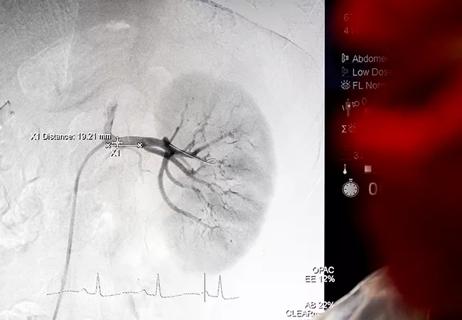Results inform dose selection for further trials of the aldosterone synthase inhibitor

Lorundrostat (MLS-101) ― an investigational medication that works by lowering aldosterone production ― safely and effectively lowered blood pressure (BP) in patients with hypertension refractory to standard medical treatment. So reported investigators with the placebo-controlled Target-HTN phase 2 clinical trial in a late-breaking clinical trials session at the American Heart Association Hypertension Scientific Sessions 2023. The study was simultaneously published in the Journal of the American Medical Association.
Advertisement
Cleveland Clinic is a non-profit academic medical center. Advertising on our site helps support our mission. We do not endorse non-Cleveland Clinic products or services. Policy
“We saw a very robust blood pressure lowering response, particularly in study participants with obesity, a major driver of hypertension in this country,” says first author and study presenter Luke Laffin, MD, staff cardiologist in Cleveland Clinic’s Section of Preventive Cardiology. “Lorundrostat has the potential to become an important new tool to help this hard-to-treat population and others with uncontrolled hypertension.”
Excess aldosterone has been implicated in contributing to hypertension in patients with obesity, metabolic syndrome and obstructive sleep apnea. In such individuals, the normal feedback loop of elevated aldosterone leading to increased renin activity ― which inhibits further aldosterone synthesis ― is disrupted.
If the standard three-drug regimen for treating hypertension (a thiazide diuretic, a calcium channel blocker, and an angiotensin-converting enzyme inhibitor or angiotensin receptor blocker) does not adequately control BP, a mineralocorticoid receptor antagonist (MRA), typically spironolactone, is added. While spironolactone binds intracellular aldosterone receptors, leading to BP lowering, its use is limited by side effects. In addition, circulating aldosterone levels may actually increase as a result of receptor blocking, enhancing nongenomic effects of aldosterone and leading to excess sympathetic activation, disrupted glucose homeostasis and negative vascular effects.
Lorundrostat is in a novel class of drugs that lower aldosterone by inhibiting aldosterone synthase rather than blocking mineralocorticoid receptors. The orally administered medication has the potential to lower BP without the adverse effects of an MRA. The first aldosterone synthase inhibitor, osilodrostat, interfered with cortisol production. Baxdrostat, a more specific drug similar to lorundrostat, has performed well in a phase 2 clinical trial.
Advertisement
The current Target-HTN trial (NCT05001945) was designed to test lorundrostat’s safety and efficacy, especially among patients with suppressed renin activity, and to help determine dosages for future trials.
“The development of lorundrostat is important because no new class of blood pressure-lowering drugs has been introduced for many years,” says the study’s senior author, Steven Nissen, MD, Chief Academic Officer of Cleveland Clinic’s Heart, Vascular & Thoracic Institute. “Blood pressure is difficult to control in some patients, particularly those with obesity and diabetes, so new options will be valuable.”
The prospective, randomized, double-blind Target-HTN study was conducted at 43 U.S. sites, including Cleveland Clinic. The Cleveland Clinic Coordinating Center for Clinical Research (C5Research) independently confirmed the primary endpoint analysis.
To qualify for participation, patients had to have a minimum systolic BP of 130 mmHg despite taking at least two antihypertensive medications. The study’s 200 patients were enrolled into two cohorts, with the initial cohort (cohort 1) consisting of patients with suppressed plasma renin activity (≤ 1.0 ng/mL/h) and elevated serum aldosterone (> 1.0 ng/dL) and a subsequent smaller cohort (cohort 2) consisting of patients without suppressed plasma renin activity (> 1.0 ng/mL/h). The cohorts were treated as follows:
Advertisement
Patients continued their existing background antihypertensive medications during study treatment. Mean age of the overall study population was 65.7 years, 60% were women, 48% were Hispanic and 36% were Black.
Nearly half of participants (48%) had a body mass index of more than 30 kg/m2 and 40% had type 2 diabetes.
All participants underwent a two-week placebo run-in period. After randomization, they were monitored with automated office BP measurements weekly throughout the study. The primary efficacy endpoint was change in systolic BP from baseline to week 8.
Key efficacy findings were as follows:
Most adverse events were classified as mild. No cases of cortisol insufficiency occurred. One serious adverse event was believed to be treatment-related: a patient in cohort 2 on lorundrostat 100 mg developed worsening hyponatremia, requiring drug discontinuation. Mean serum potassium increases were similar across all doses of lorundrostat. Serum potassium rose above 6.0 mmol/L in six patients but was corrected with dose reduction or drug discontinuation and required no further intervention.
Advertisement
“The 50-mg daily dose lowered blood pressure to a similar degree as 100 mg, but with fewer adverse events,” Dr. Laffin observes.
Dr. Laffin notes two trials using lorundrostat that Cleveland Clinic and C5Research are helping to lead:
“Target-HTN has found lorundrostat to be well tolerated and to confer significant and clinically meaningful blood pressure reduction in patients with hypertension refractory to standard therapy,” Dr. Laffin summarizes. “These findings suggest that a targeted approach to blood pressure management might be useful, especially for those with elevated aldosterone.”
Advertisement
Advertisement

Phase 2b trial of aldosterone synthase inhibitor also finds no benefit from dose escalation

Clinicians should individualize dosing practices based on patient risk factors and preferences

General principles for use of the long-awaited new therapy approach

Getting patients to their goal blood pressure

Researchers develop first-of-its-kind neoantigen atlas to better understand immunotherapy resistance

TRANSITION-T2D RCT results for patients with T2D receiving MDI

Real-world claims data and tissue culture studies set the stage for randomized clinical testing

New review distills insights from studies over the past decade